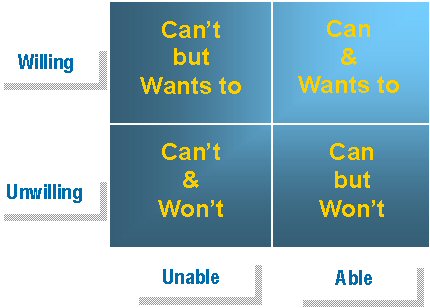
Let's continue our journey to the world of Situational Leadership. In my previous post I introduced the model and explained Step 1 to you, which was all about defining the task and finding out which level of detail we need to apply in our communication. Let's now continue with Step 2.
After defining the task we are about to assess current performance readiness. Here the model uses two very simple indicators, which again can be seen in everyday practice: willingness and ability
Dr. Hershey, one of the founders of this model explains these indicators this way:
“Ability (knowledge, experience and skill) and willingness (confidence, commitment and motivation) are an interactive influence system. The better I am at something, the more willing I will be to take responsibility for producing/delivering desired results. The more willing I am to learn how to perform a new task, the quicker I will have a tendency to develop the skills necessary to perform on my own.” (Paul Hershey, The Situational Leader, Center for Leadership Studies, 1984)

Both indicators should be assessed when you are thinking about the current performance of your colleague on a given task. And as you can see above, these two are interrelated, have an effect on each other. Let’s see a few examples:
Ability high/willingness low: these are the least favorite activities. For example in a household taking out the trash. In our neighborhood the trash truck comes Monday morning. When do you think the trash comes out from my house?
Sunday night earliest, but rather 6.55 Monday morning (the trash truck arrives around 7 a.m.). Well, I have to admit that stink is an urge, therefore stinky things go out immediately. :-D
So this is an example when the least favorite part can override actual performance. I have all the abilities, I just don’t want. And I don’t want it until the very critical moment, i.e. until the very end.
Willingness high/ability low: I truly admire good singers. I took several lessons, but the teacher was finally honest with me and said “Save your money, you’ll never be a good singer.” I was absolutely keen on singing, enjoyed it a lot, even put a lot of effort into it, but I lacked the talent...
Do you have tasks similar to these examples? I am sure you do, as everybody else. Just look around at your workplace and try to find examples of these two extremes (willingness high/ability low and ability high/willingness low).
The key concept in the Situational Leadership model is that people might CHANGE, therefore we are not reacting to performance of last week/month or the previous year, we are not looking at the history of the person. We just take a look the the current moment and assess what we see RIGHT NOW.

Ability can be very objective, measurable, tangible, whereas willingness is rather subjective, difficult to read, intangible. You may perceive well extreme confidence, but you might be very hesitant to assess lower levels.
As you see from the definition above there are “subparts” to both ability and willingness. Ability means knowledge, experience and skill, while willingness entails confidence, commitment and motivation. Experience (has done) doesn’t have to be exactly the same as the job under investigation. Any related experience will do. Skill means that we are doing the exact task RIGHT NOW (so we know eaxctly how to do it).
You have to note that this is not a mathematical equation. One that is negative out of the three components can often be the one that drives or overpowers the others. So remember that MATHS DOESN’T APPLY HERE. It’s rather situational, I always have to find out more about the current situation. I have to see what is the overall performance that we are getting.
E.g. as I mentioned there is a household activity that I really hate doing: taking out the trash. Well, let’s see this. Does Kriszta have knowledge/experience/skill taking out the trash? Well, obviously I have the knowledge and experience. How about skill? Friday night I have no skill, because then I am not doing it. Monday morning I have the skill, and I do it.
How about confidence, commitment and motivation? Well, on days other than Monday I seem to have no confidence and commitment. Well, stink and time may force me to do it, but motivation I still don’t have.

Some hints from practice:
When we are assessing performance we always focus on demonstrated skills (should be able to do that or used to be able to do that are not applicable here).
Also it is very important not to confuse enthusiasm with ability! (This might happen easily with Newbies!)
And finally impacting knowledge doesn’t guarantee skill: sitting and absorbing the information cognitively is one side of the coin, and trying to do it in practice is the other. Knowing how to do something is not enough, we need to try it and master it in order to be able to use it.
The main question here at this step is this: is the person performing? Yes or No? Do we have to intervene somehow as leaders?

There are four performance readiness levels in this model:
R1 (low ability/low willingness)
The key is “Defensiveness or discomfort”. Even if they are insecure, they tend to be defensive, because they do not want to admit this. Progression towards the next level is driven by willingness. He becomes excited, but still not performing right now.
Newbies are on this level, because they have no ability at the moment and tough they might demonstrate a considerable level of enthusiasm towards the company or the department, they cannot be motivated towards the exact task, because they have no experience in it.
Burnt-out employees, who demonstrate a serious drop in performance are also on this level. We have to re-gain their cooperation as leaders, so we have to start to build up our relationship from zero.
R2 (low ability(high willingness)
The key is: “Receptive to input”. At this phase people start to have some experience, they might have tried out a few steps of the task, they start to understand the basics, and as they progress, they are going to have more and more questions. This is the time when they have SOME experience, but they lack the big picture yet, they do not understand overall processes, company policies etc., therefore we cannot leave them alone. They are very enthusiastic usually, but do not be mislead by this: they still lack the ability.
R3 (high ability/low willingness)
There can be many reasons for someone falling into this category:
“First time solo performance”: we fail as leaders to realize that, he knows how to do it, he has the ability, he is actually doing it, but lacks self-confidence yet.
Sometimes people belong to this category due to family problems for example the employee in the middle of a divorce is not focusing 100% on the job. He was a peak performer and still doing a great job, but you can see that his thoughts are elsewhere.
Disappointed people, this is the first step of burning out at the workplace, there is no drop in performance yet, the person is still doing a great job, but motivation has dropped significantly. If we lose him as leaders, performance will continue to drop and the person can fall down to level R1.
Perfectionists are usually at this level: they can perform at a peak level, but they are never satisfied with their performance, they always need reinforcement from the leader.
R4 (high ability/high willingness)
“Can operate autonomously”: do they come to our office with their clipboard listing a lot of questions or not? If it is important to keep you informed about every tiny bit of the job, then it is a sign… (Remember that with R4 people we usually talk at an overall level: objectives, goals, milestones, etc.)
They are the ones you can understand each other with from a few words. They are your shining stars at the workplace, your top performers, but remember, if you put all the burden on them as a leader and never praise them, they soon start to get tired and lose motivation.
Do we want to have every employee to be R4?
Theoretically we might answer yes, but then we would face a lot of problems. E.g. whom are we going to promote? It is unrealistic to make everybody perfect. But the healthy (or ideal) situation is when you have at least one or two peak performers at every important task your colleagues are doing.

Well this was Step 2 in this model: assessing performance readiness, in other words seeing how much effort do we need to put into high performance of a given employee at a given task.
In the next part we will continue our journey with the final step, when we match leadership style to the assessed readiness level of the employee. Stay tuned! :-)
If you are interested in the previous parts of this series, you can find them here:
https://steemit.com/leadership/@ksolymosi/the-mystery-of-leadership-part-one
https://steemit.com/leadership/@ksolymosi/the-mystery-of-leadership-part-two
https://steemit.com/leadership/@ksolymosi/the-mystery-of-leadership-part-three
Sources of pictures
Congratulations! This post has been upvoted from the communal account, @minnowsupport, by Kriszta from the Minnow Support Project. It's a witness project run by aggroed, ausbitbank, teamsteem, theprophet0, someguy123, neoxian, followbtcnews/crimsonclad, and netuoso. The goal is to help Steemit grow by supporting Minnows and creating a social network. Please find us in the Peace, Abundance, and Liberty Network (PALnet) Discord Channel. It's a completely public and open space to all members of the Steemit community who voluntarily choose to be there.
If you would like to delegate to the Minnow Support Project you can do so by clicking on the following links: 50SP, 100SP, 250SP, 500SP, 1000SP, 5000SP. Be sure to leave at least 50SP undelegated on your account.
Downvoting a post can decrease pending rewards and make it less visible. Common reasons:
Submit
This post has received a 0.63 % upvote from @drotto thanks to: @banjo.
Downvoting a post can decrease pending rewards and make it less visible. Common reasons:
Submit
You got a 19.43% upvote from @postpromoter courtesy of @ksolymosi!
Downvoting a post can decrease pending rewards and make it less visible. Common reasons:
Submit